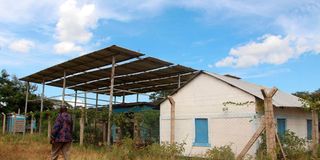Let us emulate record solar power output by Germany

A man walks past solar panels that power the Kaiti/Kamunyii water project in Makueni.
Historians reckon that Hitler’s biggest mistake was the Battle of Barbarossa. If Napoleon met his match at Waterloo, then the beginning of the end of Hitler was the failure of Operation Barbarossa—an invasion of the Soviet Union by Nazi Germany and its Axis allies on Sunday, June 22, 1941 on the backdrop of World War 2.
This military campaign stands as one of the most extensive and devastating land offensives in recorded history, involving 10 million combatants. It resulted in over eight million casualties, marking it as one of the deadliest chapters of the war.
It was Hitler’s plan to open up the Eastern Front but Moscow became his most elusive target. And it was not the famous Russian meat grinder tactic, where Russian generals throw wave after wave of infantry for slaughter and depend on sheer numbers—a tactic so beloved by Russian generals they are doing the same in Ukraine—that was Moscow’s greatest line of defence. The weather, more specifically its winter, came to the aid of Moscow, just as it had done before in the Napoleonic wars.
The setback marked a pivotal turning point: The German War Machine, Wehrmacht, found itself unable to sustain attacks across the Eastern Front.
Strategic advantage
Control of energy was Hitler’s ultimate goal. Russia then, as now, had huge oil reserves that would have given strategic advantage to his expansionist dream. Fast-forward and the shoe is on the other foot, with Mother Russia the aggressor. One of the first things Germany did was to wean itself from its addiction from Russian gas supplies through NORD Stream.
In typical German ingenuity, the country diversified its energy mix, which included a great deal of renewables. In fact, Germany has experienced a remarkable surge in solar power production, with solar farms contributing over 60 per cent of the country’s electricity for several hours each day over the past week. This increase in solar generation capacity, coupled with bright sunshine, has propelled Germany’s energy transition away from fossil fuels.
Data from LSEG, a trusted global financial markets infrastructure and data provider, show solar farms in Germany produced 17,531 megawatt hours (MWh) of electricity during the week ending May 13, representing a 40 per cent increase compared to the previous week and nearly 50 per cent higher than the long-term average for the same period. The recent stretch of clear and sunny skies has been the driving force behind this solar surge with peak production typically occurring around midday.
At 1 p.m. on May 13, solar assets generated a remarkable 43.8 gigawatts (GW) of electricity out of the total 72.4 GW generated in Germany at that time. This means that solar power accounted for nearly two-thirds of Germany’s total electricity output during that hour, surpassing output from wind farms, coal and natural gas plants.
Geothermal energy
In Kenya, solar power even on the best of days, brings the least in our power mix. Notably according to Statista.com, in September 2023, Kenya relied predominantly on geothermal and hydro energy as its primary sources of electricity production.
During that month, the nation harnessed 512 million and 247 million kilowatt hours from these respective sources. Wind energy contributed 141 million kilowatt hours, while solar power contributed 39 million kilowatt hours to the overall electricity generation, this means solar power even at best of times generate 4.15 per cent of total generation.
If we harnessed our year-round solar blessing through rooftop domestic solar, we can surpass Germany’s production and have solar as a key source in our energy mix. Perhaps then we can do away with diesel-powered independent power producers.
Ms Hassan is business development manager, SolarNow Services (EA) Ltd. [email protected].





